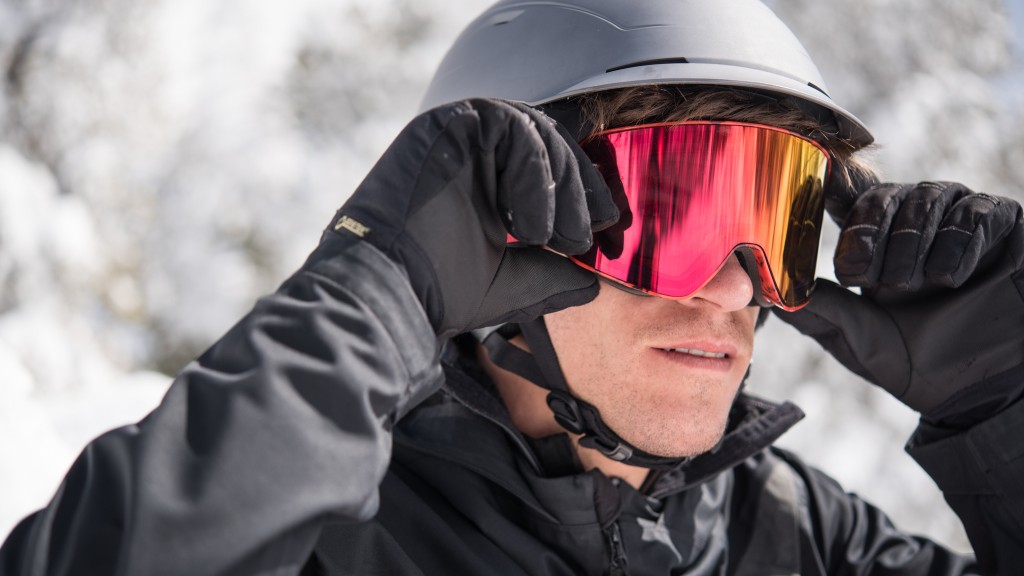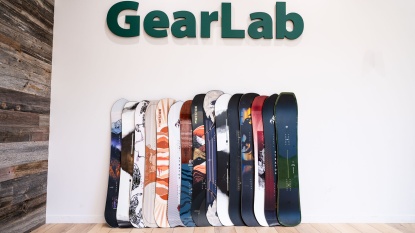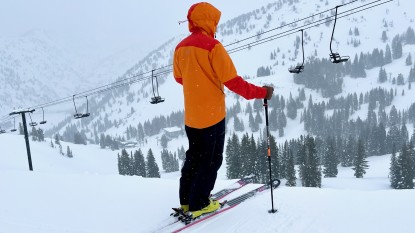We understand if you feel overwhelmed looking at the ski and snowboard helmet selection at your local shop. With so many options and marketing slogans, selecting the best snow helmet for you can seem like a daunting task. We are here to help. We will break down the key attributes such as ventilation and adjustment systems to consider when purchasing a new brain bucket. At its core, a helmet should be comfortable, warm yet ventilated, and up to the industry impact standards. We all know accidents happen. Helmets are designed to keep you on the slopes and minimize your chance of brain injury. We bought and tested the top options available today to help you identify the most desirable design characteristics and fit for you. Continue reading for more information to help you purchase the helmet you'll actually wear every time.
Should You Wear a Helmet?
The short answer is yes. If you're careening, bombing, schussing, barreling, sliding, or in any other way allowing gravity to pull you down a snowy, icy hill at any speed, you should be wearing a helmet. Period. Helmet usage has increased massively in the past few decades, and for a good reason. The sport continues to progress at the professional and recreational levels due to advances in equipment and slope maintenance technology. These factors have resulted in people skiing faster and jumping higher in increasingly challenging terrain. Helmet manufacturers have met the market to suit the needs. Their product offerings have become increasingly comfortable, warm, versatile, and stylish.
It's hard for manufacturers or the industry to prove that wearing a helmet improves your chances of surviving a severe traumatic brain injury. Still, it's also hard to argue that a safety-rated helmet won't absorb some of the energy during a blow to the head.
Ski and Snowboard Helmet Certifications
There is no US law to mandate any protective standards of snowsports helmets. Fortunately, two independent organizations certify snow helmets to a safety standard. Most retailers in the US only sell products that meet either one or both of these standards.
American Society for Testing and Materials (ASTM)
The American Society for Testing and Materials (ASTM) is the American Standard for brands producing helmets for US Sale.
The ASTM F2040 is the certification given to snow helmets that have fully passed the ASTM testing requirements. This certification focuses on dynamic strength retention and positional stability.
European Committee for Standardization (CEN)
The European Committee for Standardization (CEN) also certifies helmets and further divides helmets into Class A, and Class B. Class A helmets are the most protective and require that the helmet is made in “full shell” or “full face” style. Class B helmets are less protective based on service area but allow the user's ears to be exposed for better communication. All of the certified helmets we tested meet the CEN Class B standard.
The EN 1077A/B is the certification title provided by the CEN and focuses primarily on impact testing.
Takeaway
Both certifications provide a strict safety threshold that a product needs to meet or exceed. Each certification requires ample testing to ensure the product meets that standard. We recommend purchasing a helmet certified by one or both of these agencies. If you are shopping in person, look inside the helmet for a sticker stating its certification. If you are shopping online, then be sure to double-check the product description. Every helmet in our review meets one or both of these standards.
Types of Helmets
Helmets are categorized based on the construction methods used. Most helmets fall into two main categories: in-mold or hardshell/injection mold. A small percentage of helmets are considered specialty helmets. The main helmet categories are functionally suitable for either skiing or snowboarding.
In-Mold
An in-mold helmet consists of a thin polycarbonate (a durable plastic with high impact resistance) shell filled uniformly and thoroughly with expanded polystyrene (or EPS, which is a rigid and tough foam) in a single process.
Pros: Lighter and lower profile than hardshell helmets, increases ventilation options, i.e., more vents and strategic venting opportunity.
Cons: Generally more expensive
Hardshell / Injection Mold
This is your “skateboard” style helmet. These helmets use ABS (acrylonitrile butadiene styrene) - another tough and impact-resistant plastic bonded to the EPS foam.
Pros: Value and durability
Cons: Larger profile, heavier, can have less venting opportunity
Specialized Helmets
In the current state of the market, this category collects helmets that may be constructed in either of the above methods but cover the ears and maybe the user's face with rigid protection. For most recreational skiers and snowboarders, these helmets and their decreased comfort and increased expense will not justify their additional protection.
Rotational Impact Protection System Technology
Nearly every modern brand offers a helmet that incorporates a rotational impact protection system. This innovation is a research-driven design that has shown promise in reducing the severity and likelihood of brain injuries. Traditional helmets are great at absorbing liner impacts. However, the majority of helmet impacts are multi-directional.
Mips stands for Multi-directional Impact Protection System and is the most commonly employed rotational impact protection system in ski helmets available in the United States. Mips is what is called “slip-plane” technology. To simplify, Mips allows your helmet's inner mold and liner and the hard outer shell to stretch and slide on impact. It reduces the rotational forces that occur on impact.
Many companies, such as POC, Shred, and Leatt, have created in-house technologies to reduce rotational forces. Other prominent players such as Smith and Giro use the third-party Mips system.
Most helmet companies either include Mips across the board in their helmets or offer a Mips version for a few dollars more (typically $20). Since a helmet's primary function is to reduce the magnitude of head trauma during impact, we're on board for anything that works to improve this function. The tech makes intuitive sense. To that end, any new helmets we've tested that offer Mips as an optional upgrade, we've taken that upgrade. We think the extra protection potential of a Mips-integrated helmet is worth the additional cost.
Koroyd
Many helmets on the market are starting to incorporate an energy dispersion material called Koroyd. Koroyd is a welded tube structure that aims to absorb energy through the crumpling of thin polymer-based tubes. Koroyd states that less force is transferred to the head because the energy is absorbed in a consistent and controlled manner. Imagine the same type of collapse that occurs when you step on a soda can. In contrast, EPS foam compresses on impact, increasing its density and potentially channeling more energy to the head.
Military and action sports have increasingly been incorporating this tech into their protective gear. We have observed this material to supplement EPS Foam in critical areas of premium helmets. The material provides a more breathable and protective helmet than EPS foam. It is beyond the scope of our testing to validate this claim. Conceptually, it makes sense, and the quick adoption by many diverse industries supports the material's efficacy.
Koroyd may not be a make-or-break helmet feature, but it works to provide peace of mind and added protection. It generally increases the cost of the helmet and is found on higher-end models.
How to Choose a Snow Sports Helmet
Impact Test Results
We have had each helmet in our review professionally impact tested by a certified lab to give you additional info to consider. This gives you a way to assess whether one helmet on your short list performed better than another in those impact tests. Keep in mind that all the helmets in our review have passed multiple safety regulatory requirements, and so they can all be considered safe. So, from our point of view, the Impact Test results are not the sole factor we think you should consider. We encourage you to consider multiple factors in your purchase decision-making, and that is why we test performance and features in detail, to give you a complete picture of each helmet's all-around performance.
Fit
Similar to apparel, the fit of your ski helmet is crucial and personal. A helmet needs to be comfortable enough to wear all day, and the best fit will have no headache-inducing pressure points. Additionally, a ski helmet offers additional protection from the cold and wind. The fit directly affects comfort and the efficacy of elemental protection.
Manufacturer's Sizing Info
We encourage you to visit the manufacturer's website, and follow their instructions to properly size your head in their helmets. Since so many people buy helmets online today, the manufacturers all strive to provide clear and easy to understand instructions to enable you to carefully measure and fit your head properly in their product family and available sizes.
Our advice is to narrow down your selection using our review, and then once you have one or two final contenders, proceed to the manufacturer's site (rather than an online retailer's site) to dial in the size that will work for you.
If you are buying online and you are not 100% sure which size will be right for you, you may want to borrow a trick from people who frequently buy shoes online. Order several sizes of helmets from an online retailer with a generous return policy (we find REI to be a terrific online retailer to buy from due to their easy and compelling return policy). Then, return the size or sizes that don't fit.
Backcountry Skiing vs. Resort Skiing
Backcountry skiing seems to be increasing in popularity every year. We know this because our favorite backcountry spots seem to be getting more crowded, especially on weekends. While we have the moment, we'd be remiss not to mention that if you're traveling in the backcountry in any fashion, you really should have a full backcountry setup. That means an avalanche beacon, probe, and shovel. We also recommend considering an avalanche airbag backpack).
As far as helmets go, outside of the Salomon MTN Lab, which is aimed almost exclusively at backcountry skiing, most helmets will suffice just fine at the resort or out in the woods. Skiing in the backcountry can hold exciting technical ascents like booting up a steep couloir in a spring corn cycle. Helmets are very encouraged for this terrain to help manage the rockfall hazard. These activities can often be very sweaty endeavors, and ventilation becomes paramount.
Weight is another critical metric for backcountry skiers. You're already going uphill for a solid chunk of your day; reducing weight is desirable. A few ounces may not seem like much, but those ounces begin to add up when you can save that in multiple areas of your complete setup. As for resort skiing, unless you're particularly petite, letting gravity do its thing isn't going to have a massive impact on the weight of your helmet.
Any helmet we've tested here will protect you in the front-, side-, or backcountry, and many people will be perfectly content with whatever helmet they decide on wherever they choose to ride on a given day. With the rise of backcountry skiing, it is valuable to point out the differences and how they should affect your helmet purchasing decisions.
Warmth and Venting
Ski and snowboard helmets have come a long way in the past couple of decades - if you're not already privy, you'll be blown away by how modern helmets can be so warm and vent so well all at once. The most versatile helmets have vents in the shell that can be opened or closed with an easy-to-use toggle, generally on top of the helmet. In conjunction with removable earpieces, this feature makes for the coolest, best-vented helmets on the market. Others have vents that are open all the time, allowing air to flow through the helmet whether or not you want it. Our testers found that helmets of this nature were best used with a thin beanie or buff underneath the helmet.
When considering which helmet to buy, consider your temperature thresholds. Consider a warm helmet with closable vents and snug-fitting earpieces if you get hot and cold easily. If you run hot and want maximum ventilation, consider a helmet with more than ten vents.
Also, consider the climate where you do most of your riding. Warmer climates with maritime snowpacks (most parts of the Cascades and Sierras) allow skiers to get away with less warm helmets. Colder climates with continental snowpacks (Rocky Mountains, Brooks Range) will find a warm helmet a more necessary bit of protection.
Considering these factors before buying a helmet will benefit you once you're on the hill.
Goggle Compatibility
Aside from a good fit, a helmet's compatibility with the goggles you'll be using is of utmost importance. The difference between a nice snug interface and a big gap can be excruciatingly evident on a cold day. The dreaded “gaper gap” between the top of the goggles and the helmet can leave you with brain freeze on a cold day and finger-pointing in lift lines.
Buying both your helmet and goggles from the same company will generally mitigate this issue, but if that's not an option, then bringing your goggles with you when you try on helmets is a good idea. Our reviewers encountered an issue when the goggles were too big for the space from the bridge of the nose to the helmet's brim. If there is not enough space, it can feel like the goggles are being pushed down onto your face.
You can manage the “gaper gap” and the aforementioned spatial issue by sizing the helmet so that the brim should be about 1-1.5 inches above the line of your eyebrows.
In this review, we rated each helmet for its goggle compatibility, both with goggles from the same company and others. Keeping in mind that what works for one person's face might not work for someone else's, making a hands-on test pretty crucial for the selection of your helmet/goggle combo.
Features and Accessories
Finding the right helmet and the perfect goggle to match is paramount to having a good skiing experience. After you've done that, you can consider any other accessories you might be interested in. Many of these helmets have options for POV helmet mounts, removable earpieces, magnetic buckles, and audio packages. The Salomon MTN Lab, as a backcountry-specific helmet, has a headlamp retainer that works to keep the strap of your headlamp securely around your helmet for early morning ascents. Features can create a product experience geared toward your personal needs. If you like to jam to your favorite tunes while riding, select a helmet with audio-compatible earpieces.
Many of the helmets we reviewed are compatible with audio systems. For those that are not audio compatible, it is easily supplemented with headphones. Be aware that loud music can alter your situational awareness of riders near and around you. The last thing you want is to collide with a fellow skier due to your lack of awareness.
Style
Although not as important as fit, comfort, or protection, style can still play a significant role in our helmet choice. Many people are reticent about wearing a helmet because they think it makes them look strange. We believe this mentality is outdated. Nowadays, there is a helmet to fit every head and every sense of style. As we've mentioned previously, the injection-molded helmets tend to be a bit bulkier, while the in-molded helmets are sleeker and usually have more features. Most of these helmets come in various colors, from earth tones to bright two-toned colors. Find a style that works for you and your outfit and go with it; your friends will learn to spot you in the lift line regardless.






















